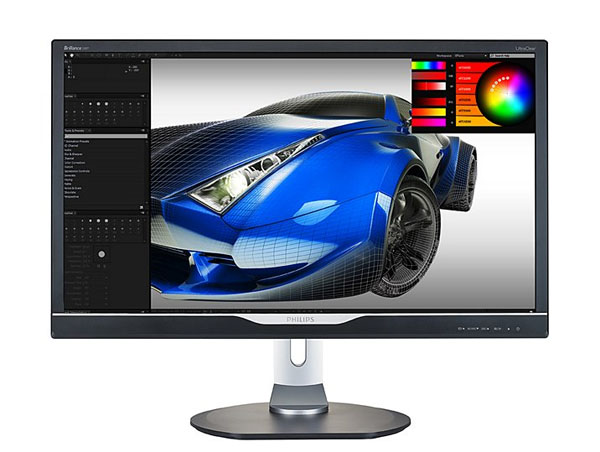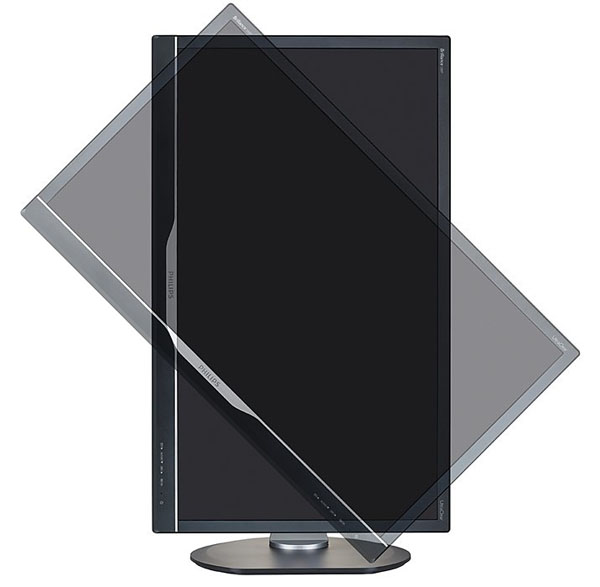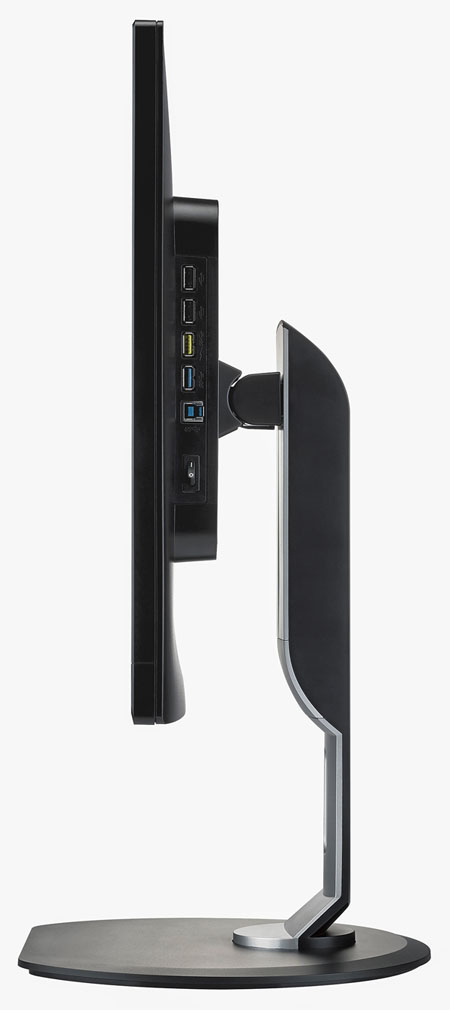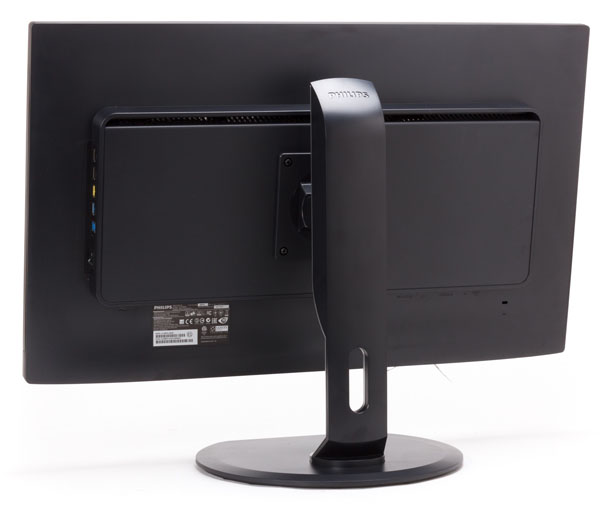Philips 288P6LJEB 28-Inch Ultra HD Monitor Review
We're hard at work reviewing every 4K screen we can get our hands on so that you know which one is best. With our evaluation of Philips' 288P6LJEB, only one available monitor remains. How does this 28" Ultra HD display size up to its competition?
Why you can trust Tom's Hardware
Packaging, Physical Layout And Accessories
The 288P6LJEB ships in what appears to be a suitcase-style box. But once you slit the tape, you realize it’s a lay-down carton that's much easier to unpack since the accessories are in an easy-to-lift-out foam tray. The upright is already attached, so all you have to do is screw on the base with a captive bolt.
The power supply is internal, but the included cord is not IEC-compatible. Rather it’s similar to the triangular connector you plug into a laptop’s power brick. You also get HDMI, DVI, DisplayPort, VGA and analog audio cables. Curiously, there is no USB cord, even though the monitor supports version 3.0 in its upstream port. Rounding out the bundle is a driver disc and printed quick-start guide.
Product 360
The 288P6LJEB has the same light anti-glare coating we’ve seen on other 28-inch TN panels. It won’t impact image quality in the slightest, but you’ll want to be careful of placement near bright light sources. The bezel itself is nicely styled with a mixture of brushed-finish black plastic and chrome accents. The base and upright are solid pieces that are also well-finished. There is a nice heft and solidness to the whole package.
Front-panel controls are touch-sensitive and marked with small printed icons. They activate with the slightest provocation, so tread carefully when changing settings. The bezel measures 18mm at the sides and top, so multi-screen users will appreciate the slim line between monitors.
There are a full range of ergonomic adjustments available from the high-quality stand. You get the above-pictured portrait mode along with 25 degrees tilt, 65 degrees of swivel to either side, plus a generous six inches (150mm) of height. All the movements are properly damped and free of play or wobble. If you plan to line up two or three 288P6LJEBs in portrait mode, you may be stymied by the wide 1.3-inch (33mm) bottom bezel.
The Philips display is very slim from the side at only two inches (50mm). All of the USB ports, including the upstream connection, are on the right side of the panel’s power bulge. There is also a power switch there. Unfortunately, the audio ports are on the bottom. We prefer to see at least the headphone jack in a more accessible spot.
That slight flare you see at the bottom is to accommodate down-firing speakers. They are fairly beefy at three watts apiece and sound better than most, since they don’t fire back at the wall.
Get Tom's Hardware's best news and in-depth reviews, straight to your inbox.
The panel’s back is flat and smooth, making it a great choice for flush wall-mounting. Four screws release the stock upright to reveal a 100mm VESA mount. There is surprisingly little ventilation, though we observed no heat-related issues during our tests.
The input panel carries one each of DVI, HDMI/MHL, DisplayPort 1.2 and VGA for video. Analog jacks include a stereo in and a headphone out. In this photo, you can just see the speaker grills on either side.
Current page: Packaging, Physical Layout And Accessories
Prev Page Philips 288P6LJEB 28-inch Ultra HD Monitor Review Next Page OSD Setup And Calibration Of The Philips 288P6LJEB
Christian Eberle is a Contributing Editor for Tom's Hardware US. He's a veteran reviewer of A/V equipment, specializing in monitors. Christian began his obsession with tech when he built his first PC in 1991, a 286 running DOS 3.0 at a blazing 12MHz. In 2006, he undertook training from the Imaging Science Foundation in video calibration and testing and thus started a passion for precise imaging that persists to this day. He is also a professional musician with a degree from the New England Conservatory as a classical bassoonist which he used to good effect as a performer with the West Point Army Band from 1987 to 2013. He enjoys watching movies and listening to high-end audio in his custom-built home theater and can be seen riding trails near his home on a race-ready ICE VTX recumbent trike. Christian enjoys the endless summer in Florida where he lives with his wife and Chihuahua and plays with orchestras around the state.
-
envy14tpe It seems as though this is a 4k gaming monitor but I don't think that really lives up to the demand for fast fps gaming. 2160p sounds great but if its lag isn't that good it loses out to the 1440p 144Hz Asus PG278Q monitor. That seems more appropriate for gaming.Reply
I know this review is about 4k gaming but I'd like to see how the speed of a 1440p compares. There is a tradeoff when you take resolution over speed. -
ubercake Great review.Reply
If I'm looking in the $799 price range, I'm looking for higher-than-1080p resolutions and I'm either looking for the color accuracy of an IPS or PLS monitor for work purposes or I'm looking for TN gaming performance.
Since this is a TN monitor, we need to consider gaming performance. No G-sync at $799 retail? I can get the Acer 4K 60Hz with G-sync for this price or less. That's just too much for this Philips, but the Amazon price of around $580 seems closer to the target. Further, if a monitor is not using G-sync or a high refresh rate (120Hz+), I definitely wouldn't consider it for gaming. $580 might be worth simply upgrading to 4K though if you're on a 60Hz, but the contrast on this monitor kind of stinks.
Also, I'm not looking for color accuracy in a TN monitor. If I want color accuracy for matching print to screen colors, I'm looking at IPS or PLS options. On the other hand, when looking for a good TN monitor for gaming, you want good contrast for picking out bad guys in shadows and this monitor has not-so-good contrast.
I might consider this monitor for productivity, but nothing else. -
general lee "When viewed head-on, they are indistinguishable from an IPS monitor." Yeah, no. Put any solid Win 8 color to the desktop and see how the gamma shift makes upper and lower parts of the monitor look completely different, even when viewing head on. The new 4K TN panels might be color accurate to a calibrator, but it doesn't take into account the viewing angle, which is only 90 degrees in dead center of the monitor when viewed head on. These are simply not good for color accurate work, period. The same goes for VA's due to its gamma shift viewing cone. That said, these are better than the cheaper TN panels you find in budget models and 144 Hz monitors, and are good enough for non-color critical work. I'd still go for IPS for color work, and VA for media consumption due to it's superior contrast. TN is only good for fast-paced CS:GO type gaming where motion performance and visibility trumps any picture quality concerns.Reply -
ahnilated Why would you buy a monitor that is not true 4K resolution? 4096 X 2160 is true 4K resolution and not down sampled or just cut off.Reply -
Eggz Accuracy check on the following paragraph, concerning color reproduction of 4K displays:Reply
Tom's Hardware said:We covered the subject of pricing in Planar IX2850 28-Inch Ultra HD Monitor Review: Affordable 4K, but it bears repeating. If you want 4K today, you have three choices. At the high end are 32-inch IGZO panels from Dell, Asus and Sharp. They sell for between $2000 and $3000. The Dell UP3214Q offers a wide gamut option, while the other two are sRGB-only.
Is that correct about the Sharp display? It boasts a "1.07 Billion Color Palette." That's a 10-bit panel, I believe, unless there is some sort of trickery I'm not seeing. The touch version of the Sharp also has the same panel, boasting "1.07 billion colours." -
Eggz Accuracy check on the following paragraph, concerning color reproduction of 4K displays:Reply
Tom's Hardware said:We covered the subject of pricing in Planar IX2850 28-Inch Ultra HD Monitor Review: Affordable 4K, but it bears repeating. If you want 4K today, you have three choices. At the high end are 32-inch IGZO panels from Dell, Asus and Sharp. They sell for between $2000 and $3000. The Dell UP3214Q offers a wide gamut option, while the other two are sRGB-only.
Is that correct about the Sharp display? It boasts a "1.07 Billion Color Palette." That's a 10-bit panel, I believe, unless there is some sort of trickery I'm not seeing. The touch version of the Sharp also has the same panel, boasting "1.07 billion colours." -
Bondfc11 4K and gaming just don't mix right now. I am not a 120 or 144 hz snob by any means, but I just cannot go back to lower FPS and slightly increased lag. It is noticeable once you have been in a higher bracket for a period of time.Reply
I played a few games on a 28" ASUS and returned it - just couldn't take the pixel density (size issue on the desktop - I know scale scale scale, but I didn't like it), I didn't like the higher lag, lower FPS, and hated to have to drop the native resolution for some tasks.
Personally, I will not buy 4K until these issues are no longer issues. I find it funny when people say "well just scale up or change the native res to 1440/1080". Ok fine, but why buy 4K if you have to do those things? 4K and me are just not ready for prime time. -
wiyosaya Reply14714619 said:Oh, how I miss Sony and its Trinitron!
Agreed! Sony tossed innovation out the door when they hired its first western CEO. They have not quite yet figured out that innovation was what made Sony legendary even though they got rid of the western wonk.




